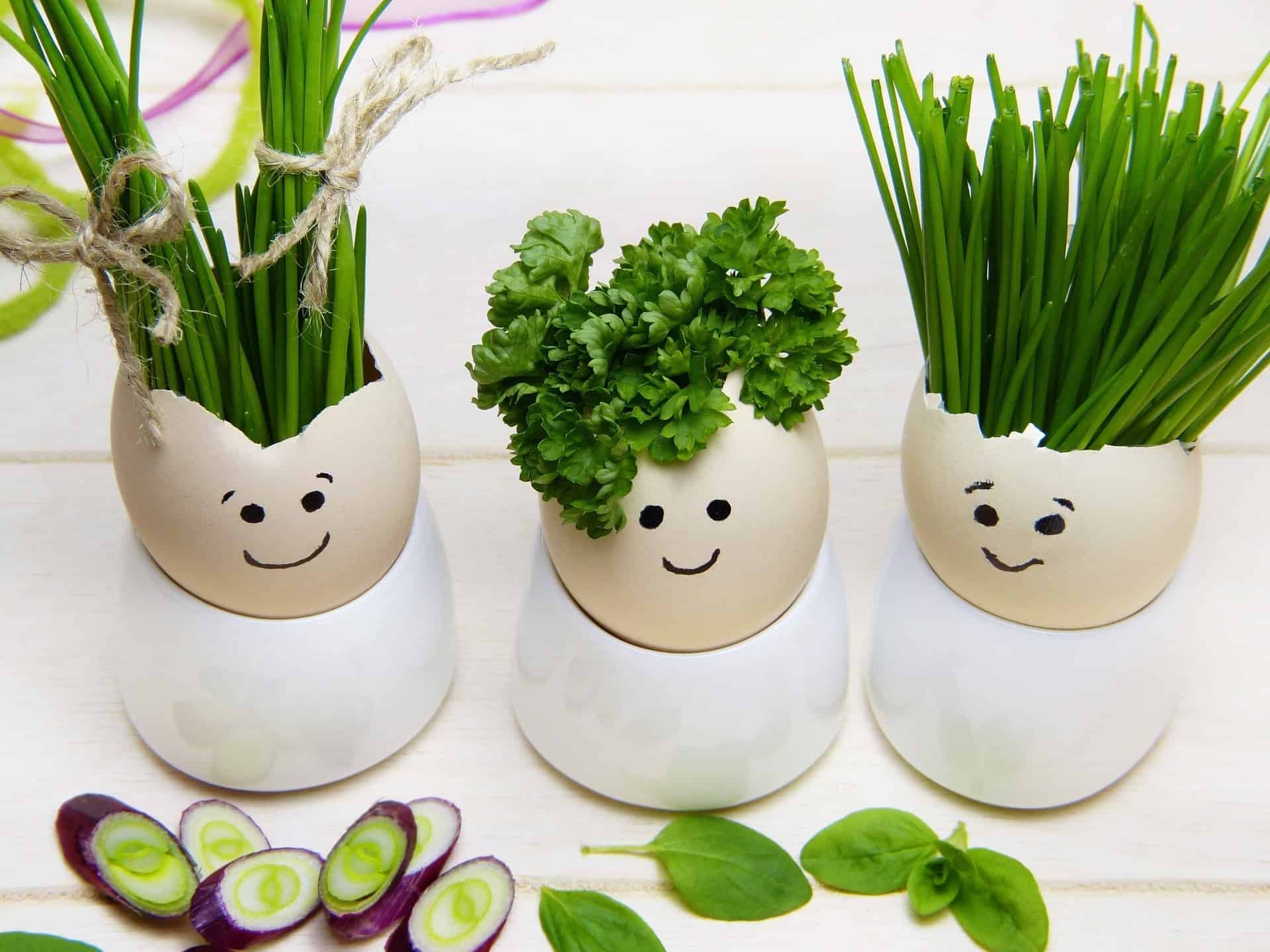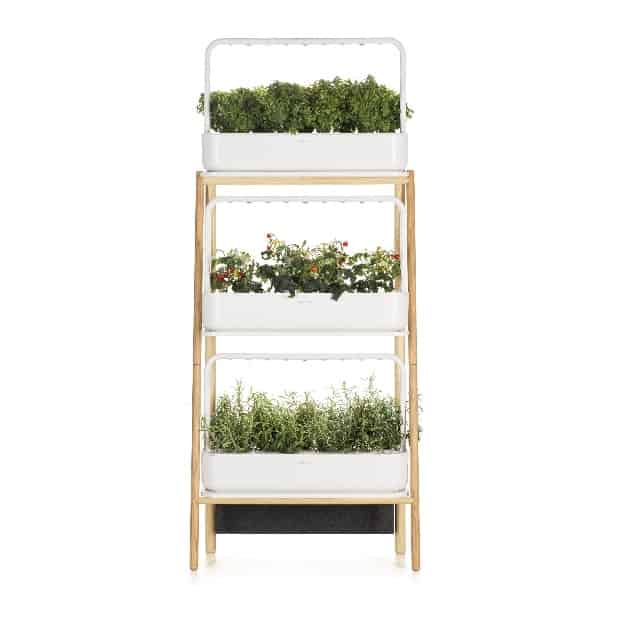Do you want to grow indoor herbs in low light? Well, luckily there are plenty of herbs that grow in shade indoors. If you’re ready to start growing herbs indoors year-round you’ll find a complete list of herbs that grow in shade on this page.
Herbs That Grow In Shade Indoors
Chervil (Anthriscus cerefolium)
Chervil (Buy Seeds Online) is an annual herb that has a sweet taste that has a flavor that’s been described as a combination of parsley and licorice. Chervil grows best in shade, and it prefers cool temperatures since it will “bolt” and go to seed in the heat. That makes chervil one of the best indoor herbs to grow in low light areas in a kitchen garden.
Chives (Allium schoenoprasum)
Chives (Buy Seeds Online) are one of the most popular indoor herbs that can grow in low light. You can grow chives in areas that get indirect sunlight, but they need to get at least 6 hours of light each day. For best results, chives should be grown near a window that gets a little sun in the morning or afternoon. If your window doesn’t get enough light then you can use a LED Grow Light (Buy Online) as a supplemental source of lighting.
Cilantro (Coriandrum sativum)
Cilantro (Buy Seeds Online) can be used in many different ways, which makes it a great addition to an indoor herb garden. Cilantro only needs 4 to 5 hours of light each day, and it can be grown indoors in a relatively shady location. However, cilantro can become leggy if it doesn’t get enough light, so you might need to provide it with some artificial light if the stems start flopping all over the place.
Lemon Balm (Melissa officinalis)
Lemon Balm (Buy Seeds Online) is a member of the mint family, and it’s a very aromatic herb that has a fresh citrus scent. Lemon balm will grow in partial shade indoors, but it will grow faster if you can give it a little sun. Lemon balm is also very easy to grow indoors since it’s not a real heavy feeder, and it isn’t very picky about soil conditions either.
Mint
Mint (Buy Seeds Online) is a great herb to grow indoors since it has a wide range of culinary uses. Mint prefers to grow in a location that gets indirect sunlight, and it also likes cool temperatures 65-70 F (18-21 C). A good location for growing mint indoors in the summer would be an east-facing window that only gets morning light. In the winter you might need to move it into a sunnier location, or you can keep it growing strong all winter under a LED Grow Light (Buy Online).
Oregano (Origanum vulgare)
Oregano (Buy Seeds Online) is frequently used in Mediterranean and Latin dishes, and it’s a great herb to grow if you want to spice up a homemade pizza. Oregano can be grown indoors in areas that get at least 6 hours of light each day. It can also be grown under supplemental lighting for a couple of hours each day in locations that don’t get enough natural sunlight.
Parsley (Petroselinum crispum)
Parsley (Buy Seeds Online) is one of the best herbs to grow indoors since it’s a very undemanding plant and it’s also very productive. Parsley grows best when it gets at least 6 hours of light each day. It also prefers to grow in rich moist soil, and it thrives in cooler temperatures.
Sweet Cicely (Myrrhis odorata)
Sweet Cicely (Buy Seeds Online) is one of the few medicinal herbs that grow in shade. It’s commonly used like celery in soups and salads, and herbalists use it to treat coughs and stomach aches. Sweet Cicely can be grown in partial shade, but it will grow faster in full sun. It also needs very rich fertile soil since it is a heavy feeder, and it needs to be fertilized frequently to fuel its rapid growth.
Tarragon (Artemisia dracunculus)
Tarragon (Buy Seeds Online) has a subtle peppery flavor, and it’s one of the fine herbs used in French cooking. Tarragon can be grown indoors in diffuse sunlight, or it will grow even faster if you can provide it with 3 to 6 hours of full sun each day. Make sure you have enough space to grow tarragon indoors since it can reach a height of 24-inches. However, with regular trimming, you can keep a tarragon plant small enough to fit into a small indoor herb garden.
Thyme
Thyme (Buy Seeds Online) is an aromatic herb that adds a subtle flavor to almost any dish. Thyme will grow in indirect light, which makes it one of the best herbs that grow in shade indoors if you don’t have much light for your herb garden. It’s also a very easy plant to grow since it doesn’t need to be watered that often, and it only needs to be fertilized on a bi-weekly basis.
Catmint (Nepeta × faassenii)
Catmint (Buy Seeds Online) is an aromatic herb that produces beautiful clusters of purple flowers, and the leaves and flowers can be used in herbal teas or even as an insect repellent. Catmint can be grown in partial shade or full sun, and it’s very easy to care for since it’s extremely drought tolerant, so you won’t have to worry if you ever forget to water it.
Sweet Woodruff (Galium odoratum)
Sweet Woodruff (Buy Seeds Online) is grown for its fresh scent, and it can even be used as a natural air freshener. Sweet Woodruff is very shade tolerant and in its native habitat, it prefers to grow under trees in rich organic soil. It’s normally grown outdoors, but it still can be grown indoors in a medium-sized container.
Indoor Herb Garden Kit
AeroGarden Harvest Elite
The AeroGarden Bounty (Buy Online) will let you grow herbs indoors on a kitchen counter or any other area that doesn’t get a lot of light. If you’re looking to start an herb garden the AeroGarden Herb Seed Pod Kit will get you off to a quick start since it features popular herbs like Parsley, Thyme, Chives, Mint, and Basil
The best thing about the AeroGarden Bounty Herb Garden is that it’s a fully automatic hydroponic growing system that helps take all the guesswork out of growing your own herbs at home.
The AeroGarden Bounty also has an adjustable LED grow light that is powerful enough to grow fruits, vegetables, and herbs that need lots of light.
AeroGarden Farm Plus
The AeroGarden Farm (Buy Online) is the best indoor hydroponic system if you want to grow herbs and larger plants like tomatoes and peppers. The AeroGarden Farm System has two electronically adjustable 60-Watt grow lights, which will allow you to grow up to 24 plants that reach a maximum height of 36-inches.
The lights on the AeroGarden Farm can be automatically raised and lowered so your plants will always get the right amount of light. It also has a built-in touch screen, and it can even be controlled via a smartphone or using a voice assistant (Amazon Alexa). If you want to learn more about the AeroGarden Farm and watch a Demonstration Video (Click Here)
Click & Grow Smart Garden 27
The Click & Grow Smart Garden 27 (Buy Online) is a stylish indoor herb garden that will let you grow herbs anywhere even in rooms that don’t get any natural light. This hydroponic kit comes with 3 Click & Grow 9-Pod Smart Gardens, along with a lovely wood plant stand with three shelves. The stand measures 47 x 26 x 10.3 inches and it’s very easy to assemble. You also get a starter kit with 9 Basil Pods, 9 Lettuce Pods, and 9 Mini Tomato Pods.
Growing Herbs Indoors With Artificial Light
Growing herbs indoors year-round can be a fun and rewarding experience. However, if you don’t have enough light it can be a challenge to get herbs to thrive indoors.
Your best option, in that case, is to try growing herbs indoors with artificial lights. This will ensure your plants produce a bountiful yield, and they will be much healthier and less prone to disease when they get enough light.
The two most popular artificial light sources you can use to grow herbs indoors are LED Grow Lights and Fluorescent Light Fixtures.
LED
LED Grow Lights (Buy Online) are one of the most efficient artificial light sources for growing plants indoors,.
LED Grow Lights focus all their energy into a spectrum of light that looks pink to the human eye since plants only absorb light in the blue and red parts of the spectrum. That helps maximize a LED Grow light’s efficiency since it doesn’t emit any light in unused parts of the light spectrum.
LED Grow Lights also run much cooler since they produce very little waste heat, so you can place them closer to your plants.
The only downside with LED Grow Lights is that they are a little more expensive to buy upfront, but they will end up paying for themselves in electricity cost savings in a matter of months.
Fluorescent
Fluorescent Lights were a very popular choice for growing herbs indoors, but in recent years they have been overtaken by LED lights. However, they are still a good light source for growing plants since they are pretty efficient and they don’t produce a lot of heat. You can also easily find fluorescent lights at most stores and they are still relatively inexpensive compared to LED Grow Lights.
Fluorescent lights do get hot to the touch though, so you need to make sure you keep your plants away from a fluorescent bulb since the heat will easily burn tender leaves. You also want to be careful with fluorescent lights since they contain toxic mercury, which means they need to be handled and disposed of properly.
Tips for Growing Herbs in Low Light
Can Rosemary Grow in Shade?
Rosemary needs at least 6 to 8 hours of strong direct sunlight each day, and rosemary isn’t well suited to growing in shade. You can grow rosemary indoors, but it needs to be slowly acclimated to getting less light for several weeks before moving it inside. This will allow the plant to adjust to living in low light conditions, but it will still need to be placed near a window that gets direct sunlight.
Can Mint Grow in Shade?
Yes, mint does grow in shade, and it prefers to grow in cool areas that get indirect sunlight throughout the day. That makes mint the perfect plant for a shade garden, and you can even grow it indoors in an area that remains in shade for most of the day.
Can Basil Grow in Shade?
Basil does not grow in the shade since it needs at least 6 to 10 hours of bright direct sunlight each day. You can grow basil indoors but it needs to be placed in a south-facing window, and for best results, it will need to be grown under a LED Grow Light to bring out its full flavor.
Can Thyme Grow in Shade?
Yes, thyme will grow in shade, and it prefers to be planted in areas that get indirect sunlight throughout the day. Thyme is also one of the indoor herbs that can grow in low light and still produce a good harvest throughout the year. It’s also a compact plant, so it will easily fit on a window sill or a countertop that has limited space.





















